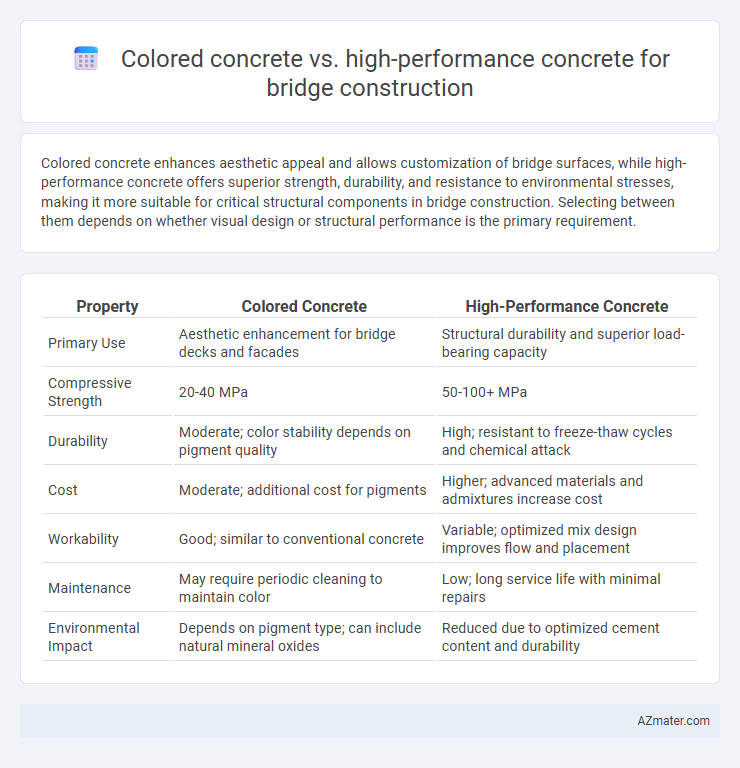Colored concrete enhances aesthetic appeal and allows customization of bridge surfaces, while high-performance concrete offers superior strength, durability, and resistance to environmental stresses, making it more suitable for critical structural components in bridge construction. Selecting between them depends on whether visual design or structural performance is the primary requirement.
Table of Comparison
| Property | Colored Concrete | High-Performance Concrete |
|---|---|---|
| Primary Use | Aesthetic enhancement for bridge decks and facades | Structural durability and superior load-bearing capacity |
| Compressive Strength | 20-40 MPa | 50-100+ MPa |
| Durability | Moderate; color stability depends on pigment quality | High; resistant to freeze-thaw cycles and chemical attack |
| Cost | Moderate; additional cost for pigments | Higher; advanced materials and admixtures increase cost |
| Workability | Good; similar to conventional concrete | Variable; optimized mix design improves flow and placement |
| Maintenance | May require periodic cleaning to maintain color | Low; long service life with minimal repairs |
| Environmental Impact | Depends on pigment type; can include natural mineral oxides | Reduced due to optimized cement content and durability |
Introduction to Bridge Construction Materials
Colored concrete enhances aesthetic appeal and offers customizable hues without compromising structural integrity, making it ideal for visible bridge elements. High-performance concrete (HPC) provides superior strength, durability, and resistance to environmental stressors, ensuring long-term performance in bridge construction. Selecting between colored concrete and HPC depends on balancing visual requirements with mechanical and durability needs specific to bridge design.
Defining Colored Concrete
Colored concrete incorporates pigments or dyes to achieve a specific aesthetic, enhancing visual appeal while maintaining basic structural properties in bridge construction. It allows for customization in hues, patterns, and finishes, supporting architectural design goals without significantly altering the concrete's fundamental durability or strength. Unlike high-performance concrete, which prioritizes advanced mechanical properties and longevity, colored concrete primarily addresses aesthetic integration within infrastructure projects.
Understanding High-Performance Concrete (HPC)
High-Performance Concrete (HPC) is engineered to provide superior durability, strength, and resistance to environmental stresses, making it ideal for bridge construction where longevity and load-bearing capacity are critical. Unlike colored concrete, which primarily emphasizes aesthetic customization through pigments, HPC incorporates advanced admixtures and optimized mix designs to enhance mechanical properties and reduce permeability. The integration of supplementary cementitious materials such as fly ash or silica fume in HPC improves its performance against freeze-thaw cycles, chloride penetration, and chemical attacks, ensuring safer and more durable bridges.
Aesthetic Value: Colored Concrete in Bridge Design
Colored concrete enhances aesthetic value in bridge construction by offering versatile design options and customizable color palettes that blend with natural surroundings or urban landscapes. Unlike high-performance concrete, which prioritizes structural strength and durability, colored concrete provides visual appeal without compromising essential performance characteristics. This balance makes colored concrete a preferred choice for architects aiming to create visually striking, yet functional, bridge structures.
Structural Performance of HPC in Bridges
High-performance concrete (HPC) exhibits superior structural performance in bridge construction due to its enhanced compressive strength, durability, and resistance to environmental stressors like freeze-thaw cycles and chloride penetration. Compared to colored concrete, which primarily serves aesthetic purposes, HPC significantly improves load-bearing capacity and extends the lifespan of bridge components under dynamic and heavy traffic loads. The optimized mix design of HPC enables reduced permeability and higher modulus of elasticity, crucial factors in maintaining structural integrity and minimizing maintenance costs for bridges.
Durability Comparison: Colored Concrete vs HPC
Colored concrete offers aesthetic advantages but generally exhibits lower durability compared to high-performance concrete (HPC) in bridge construction. HPC is formulated with optimized mix designs and admixtures, resulting in superior compressive strength, reduced permeability, and enhanced resistance to freeze-thaw cycles and chemical attacks. These durability factors make HPC a preferred choice for long-lasting bridge structures exposed to harsh environmental conditions.
Maintenance Requirements and Lifecycle Costs
Colored concrete offers aesthetic benefits but generally requires more frequent maintenance due to potential fading, staining, and surface wear, increasing long-term lifecycle costs in bridge construction. High-performance concrete (HPC) provides superior durability, reduced permeability, and higher resistance to environmental stressors, significantly lowering maintenance demands and extending the bridge's service life. Lifecycle cost analysis shows HPC's initial higher cost is offset by reduced repair frequency and enhanced structural longevity, making it more cost-effective for long-term bridge infrastructure.
Environmental Impact and Sustainability
Colored concrete often incorporates pigments without significantly altering its environmental footprint, making it suitable for aesthetic-focused bridge projects with moderate sustainability goals. High-performance concrete (HPC) enhances durability and reduces maintenance needs through optimized mix designs with supplementary cementitious materials, leading to lower lifecycle carbon emissions and longer service life in bridge construction. Emphasizing HPC in bridges supports sustainability by minimizing resource consumption, improving resilience, and reducing carbon dioxide equivalents compared to conventional or simply colored concrete options.
Application Scenarios: When to Use Each Concrete Type
Colored concrete is ideal for aesthetic bridge elements, pedestrian walkways, and urban infrastructure where visual appeal and design integration are priorities. High-performance concrete suits structural bridge components requiring superior strength, durability, and resistance to environmental stressors, such as heavy traffic loads and harsh weather conditions. Selecting the appropriate type depends on balancing aesthetic goals with structural demands to optimize bridge longevity and functionality.
Conclusion: Selecting the Optimal Concrete for Bridges
Selecting the optimal concrete for bridge construction depends on project-specific requirements such as aesthetics, durability, and load-bearing capacity. Colored concrete offers enhanced visual appeal for architectural styles, while high-performance concrete provides superior strength, durability, and resistance to environmental stressors crucial for long-span bridges. Prioritizing high-performance concrete ensures extended service life and reduced maintenance costs, making it the preferred choice for most critical bridge infrastructure.

Infographic: Colored concrete vs High-performance concrete for Bridge construction
 azmater.com
azmater.com